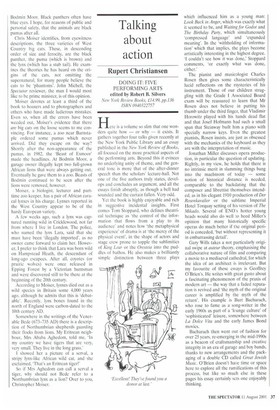Talking about action
Rupert Christiansen
DOING IT: FIVE PERFORMING ARTS edited by Robert B. Silvers New York Review Books, £14.99, pp.I36 ISBN 0940322757 Here is a volume so slim that one wonders quite how — or why — it exists. It gathers together four talks given recently at the New York Public Library and an essay published in the New York Review of Books, all focused on the more practical aspects of the performing arts. Beyond this it evinces no underlying unity of theme, and the general tone is more that of the after-dinner speech than the scholars' lecture-hall. Not one of the five authors truly states, develops and concludes an argument, and all the essays finish abruptly, as though a bell had sounded and the curtain fallen. Very odd.
Yet the book is highly enjoyable and rich in suggestive incidental insights. First comes Tom Stoppard, who defines theatrical technique as 'the control of the information that flows from a play to its audience' and notes how 'the metaphysical experience' of drama is at 'the mercy of the physical event', in the shape of actors and stage crew prone to topple the sublimities of King Lear or the Oresteia into the puddles of bathos. He also makes a brilliantly simple distinction between three plays which influenced him as a young man: Look Back in Anger, which was exactly what it seemed to be, and Waiting for Godot and The Birthday Party, which simultaneously 'compressed language' and 'expanded meaning'. In the 'withholding of information' which that implies, the plays become artistically interesting in the highest degree. 'I couldn't see how it was done,' Stoppard comments, 'or exactly what was done, either.'
The pianist and musicologist Charles Rosen then gives some characteristically lucid reflections on the mysteries of his instrument. Those of our children struggling with the Grade I Associated Board exam will be reassured to learn that Mr Rosen does not believe in putting his thumb under the third finger, that Vladimir Horowitz played with his hands dead flat and that Josef Hofmann had such a small span that Steinway built him a piano with specially narrow keys. Even the greatest pianists, Rosen insists, are just as obsessed with the mechanics of the keyboard as they are with the interpretation of music.
Jonathan Miller discusses opera production, in particular the question of updating. Rightly, in my view, he holds that there is no intrinsic merit in slamming things bang into the maelstrom of today — some notion of historical distance is needed, comparable to the backdating that the composer and librettist themselves intended, as in his elegant 1910 production of Der Rosenkavalier or the sublime Imperial Hotel Torquay setting of his version of The Mikado. Several of ENO's hotter young heads would also do well to heed Miller's opinion that many historically specific operas do much better if the original period is conceded, 'but without representing it in embarrassing detail'.
Gary Wills takes a not particularly original swipe at auteur theory, emphasising the collaborative nature of film and comparing a movie to a mediaeval cathedral, for which the idea of an architect is irrelevant. But my favourite of these essays is Geoffrey O'Brien's. He writes with great gusto about a fascinating phenomenon of the praxis of modern art — the way that a faded reputation is revived and 'the myth of the original career is amplified by the myth of the return'. His example is Burt Bacharach, who rose to fame as a song-writer in the early 1960s as part of a 'lounge culture' of 'sophisticated' leisure, somewhere between La Dolce Vita and the early James Bond movies.
Bacharach then went out of fashion for over 25 years, re-emerging in the mid-1990s as a beacon of craftsmanship and creative integrity in an era of garage and boy bands, thanks to new arrangements and the packaging of a double CD called Great Jewish Music. O'Brien doesn't have time or space here to explore all the ramifications of this process, but like so much else in these pages his essay certainly sets one enjoyably thinking.


























































 Previous page
Previous page